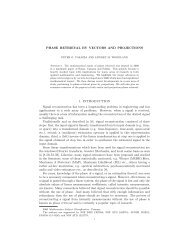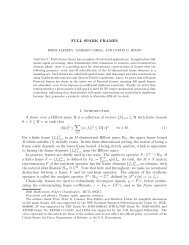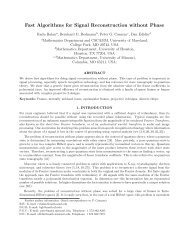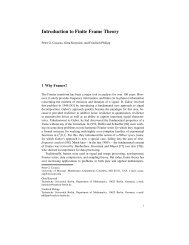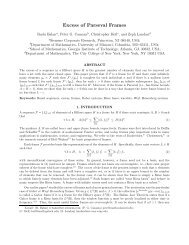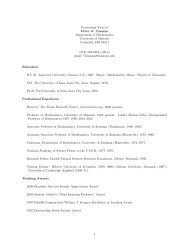The Kadison-Singer and Paulsen Problems in Finite Frame Theory
The Kadison-Singer and Paulsen Problems in Finite Frame Theory
The Kadison-Singer and Paulsen Problems in Finite Frame Theory
You also want an ePaper? Increase the reach of your titles
YUMPU automatically turns print PDFs into web optimized ePapers that Google loves.
1 <strong>The</strong> <strong>Kadison</strong>-<strong>S<strong>in</strong>ger</strong> <strong>and</strong> <strong>Paulsen</strong> <strong>Problems</strong> <strong>in</strong> F<strong>in</strong>ite <strong>Frame</strong> <strong>The</strong>ory 9<strong>The</strong>n {ψ i } i∈I is a unit norm Riesz basic sequence <strong>and</strong> for δ small enough, ψ iis close enough to ϕ i to pass <strong>in</strong>equalities from {ψ i } i∈I to {ϕ i } i∈I .<strong>The</strong> R ɛ -Conjecture is different from all other conjectures <strong>in</strong> this chapter<strong>in</strong> that it does not hold for equivalent norms on the Hilbert space <strong>in</strong> general.For example, if we renorm l 2 by: |{a i }| = ‖{a i }‖ l2 + sup i |a i | then the R ɛ -Conjecture fails for this equivalent norm. To see this, we proceed by way ofcontradiction <strong>and</strong> assume there is an 0 < ɛ < 1 <strong>and</strong> an r = r(ɛ, 2) satisfy<strong>in</strong>gthe R ɛ -Conjecture. Let {e i } 2Ni=1 be the unit vectors for l2N2 <strong>and</strong> let x i =e 2i+e √2+1 2i+1for 1 ≤ i ≤ N. This is now a unit norm Riesz basic sequence withupper Riesz bound 2. Assume we partition {1, 2, . . . , 2N} <strong>in</strong>to sets {A j } r j=1 .<strong>The</strong>n for some 1 ≤ k ≤ r we have |A k | ≥ N r . Let A ⊂ A k with |A| = N r<strong>and</strong>a i = √ 1Nfor i ∈ A. <strong>The</strong>n| ∑ ( )1 √2 ra i x i | = √ + √i∈A 2 + 1 NS<strong>in</strong>ce the norm above is bounded away from one for large N, we cannot satisfythe requirements of the R ɛ -Conjecture. It follows that a positive solution toKS would imply a fundamental new result concern<strong>in</strong>g “<strong>in</strong>ner products”, notjust norms.Another important equivalent form of PC comes from [26]. This is, onits face, a significant weaken<strong>in</strong>g of the R ɛ -Conjecture while it still rema<strong>in</strong>sequivalent to PC.Conjecture 4. <strong>The</strong>re exists a constant A > 0 <strong>and</strong> a natural number r so thatfor all natural numbers N <strong>and</strong> all T : l N 2 → l N 2 with ‖T e i ‖ = 1 for alli = 1, 2, . . . , N <strong>and</strong> ‖T ‖ ≤ 2, there is a partition {A j } r j=1 of {1, 2, . . . , N} sothat for all j = 1, 2, . . . , r <strong>and</strong> all scalars {a i } i∈Aj we have‖ ∑i∈A ja i T e i ‖ 2 ≥ A ∑<strong>The</strong>orem 3. Conjecture 4 is equivalent to PC.i∈A j|a i | 2 .Proof. S<strong>in</strong>ce PC is equivalent to the R ɛ -Conjecture, which <strong>in</strong> turn impliesConjecture 4, we just need to show that Conjecture 4 implies Conjecture1. So choose r, A satisfy<strong>in</strong>g Conjecture 4. Fix 0 < δ ≤ 3 4<strong>and</strong> let P be anorthogonal projection on l N 2 with δ(P ) ≤ δ Now, 〈P e i , e i 〉 = ‖P e i ‖ 2 ≤ δimplies ‖(I − P )e i ‖ 2 ≥ 1 − δ ≥ 1 4 . Def<strong>in</strong>e T : lN 2 → l N 2 by T e i =For any scalars {a i } N i=1 we have(I−P )ei‖(I−P )e i‖ .



